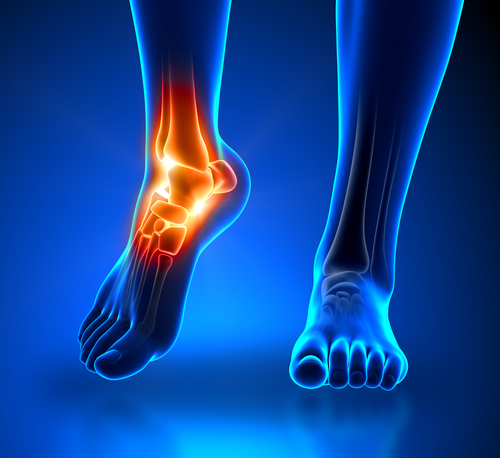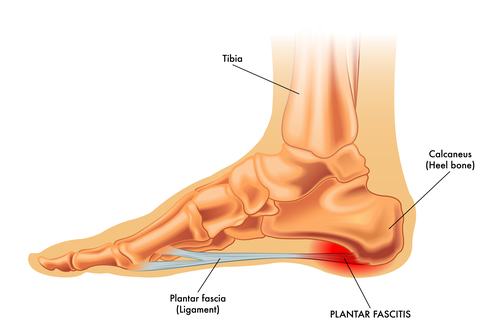“I look forward to physical activity; it’s a release from stress and a nice distraction. It puts me in a better mood. I never used to take classes before, but then I tore my plantar fascia, so I couldn’t run. I started taking SoulCycle classes, which I know are polarizing. People have strong opinions. Even though I can run again, I still go.”
— Ellie Kemper

The star actress from the show the Unbreakable Kimmy Schmidt brings a truth to a very common injury. An injury sustained to the Plantar Fasciitis isn’t something to take likely. This type of injury can go undetected and often ignored, but it’s a very serious injury and one that needs diagnosis. Let’s dive into the ways we’d diagnose Plantar Fasciitis and the ways in which Active Release Technique might be able to help.
What is Plantar Fasciitis?
We don’t want to start this thing off without educating you on what a Plantar Fascia is and what causes Plantar Fasciitis. The plantar fascia is a thick, web like ligament that connects your heel to the front of your foot. It supports the arch of your foot and helps you walk. Plantar fasciitis is one of the most common orthopedic complaints. Your plantar fascia ligaments experience a lot of wear and tear in your daily life. Normally, these ligaments act as shock absorbers, supporting the arch of the foot. Too much pressure on your feet can damage or tear the ligaments; the plantar fascia becomes inflamed, and the inflammation causes heel pain and stiffness.
Plantar Fasciitis Symptoms
There are a vast number of reasons why you can have Plantar Fasciitis. If you are over-weight or obese you will incur an increased amount of pressure on your plantar fascia ligaments. It’s common to see this in pregnant women who have sudden weight gain during the latter days of pregnancy.
Constant activity is another reason why you could develop Plantar Fasciitis. If you’re a long-distance runner, you may be more likely to develop plantar fascia problems. Active men and women between the ages of 40and 70 are at the highest risk for developing plantar fasciitis. It’s also slightly more common in women than men. Plantar Fasciitis is also known to occur with people who have high arches or flat feet. We also see this develop in people who have tight Achilles Tendons.
How can ART help with Plantar Fasciitis?
Before we can determine if Active Release Technique is the proper treatment for your Plantar Fasciitis we will inquire about your full injury history. This is the way to determine where the injury may have started and where it has proceeded. The whole strategy to determine how ART can help diagnosePlantar Fasciitis is through a series of analysis. We will try and identify how to re-introduce movement to the part of the body that has stopped moving or is struggling to move. We will start along the foot and work our way up the superficial back line. There are so many connectors to look at such as the Flexor Digitorum, Flexor Hallusis, and the fascia itself. We will also look at the things connected via connective chains to the Plantar Fascia, the Achilles Tendon, the gastrocnemius, the soleus and a few other connectors all the way up the back and through to the neck.
This extensive series of movement tests are a way to determine if you have a serious case of Plantar Fasciitis. These tests are the only way to try and diagnose how far this injury has progressed along your superficial backline and where we can go for treatment from there.
The Active Release Technique Procedure
Active Release Technique can be considered as an active type of massage therapy. We will start by shortening the muscle, tendon, or ligament, and then apply a very specific pressure with our hands as you actively stretch and lengthen the tissues. As the tissue lengthens we will be able to assess the texture and tension of the muscle to determine if the tissue is healthy or contains scar tissue that needs further treatment. When scar tissue adhesions are felt, the amount and direction of tension can be modified to treat the plantar fascia area.
An additional benefit of ART® and the resolution of Plantar Fasciitis is to allow us to further assess and correct problems not only at the site of pain itself, but also in other areas of the kinetic chain, which are associated with movement compensations and are often contributing factors to the problem. This ensures that all the soft tissues that have become dysfunctional and are contributing to the specific injury are addressed, even if they have not yet all developed pain.
Pain and Performance Solutions and your Plantar Fasciitis Needs
There’s only one way to help you through your Plantar Fasciitis. That’s to set up an appointment with us at Pain and Performance Solutions. Please don’t go another day with pain when there is help out there. Contact us at (707) 636-4404 or use our online booking page so we can help get your healing started.
Frequently Asked Questions
1. What are the early signs of plantar fasciitis?
Early signs include sharp heel pain upon waking or after long periods of rest, which affects 1 in 10 people at some point. Pain often eases with movement but worsens without treatment.
2. How does Active Release Technique (ART) help with plantar fasciitis?
ART targets scar tissue in the plantar fascia, Achilles, and calf, improving mobility and reducing pain in up to 80% of cases through manual therapy.
3. Can plantar fasciitis heal on its own?
Some mild cases improve with rest and stretching, but over 50% need professional care if pain persists beyond six weeks.
4. Is it safe to exercise with plantar fasciitis?
Yes, low-impact exercises like swimming or cycling are helpful. Regular calf stretches can reduce pain by up to 30%.
5. How soon does ART relieve plantar fasciitis symptoms?
Most people see improvement within 3–6 sessions, with 60-70% pain reduction in a few weeks.
6. Do arch supports help manage plantar fasciitis?
Yes, orthotics can reduce heel pain by 25-50% within six weeks, especially for those with high arches or flat feet.
7. Who is at higher risk of plantar fasciitis?
Risks include ages 40-60, obesity, and prolonged standing. Over 8% of runners also experience this due to repetitive strain.
8. Can ART provide permanent relief from plantar fasciitis?
ART can offer long-term relief, but recurrence is possible without proper footwear and stretching, reducing relapse risk by 30%.
9. Are there side effects to ART for plantar fasciitis?
Mild soreness or bruising may occur, affecting around 10% of people, but this typically subsides in 1-2 days.
10. Can plantar fasciitis return after ART treatment?
Yes, recurrence happens in up to 30% of cases if foot care isn’t maintained, but regular stretching helps prevent it.


